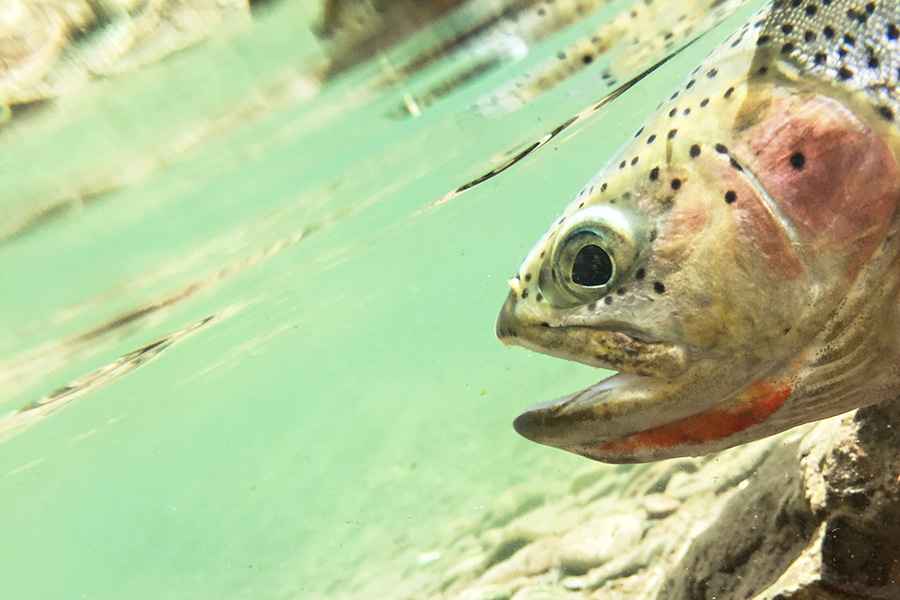The largest conservation project in the country aimed at restoring native westslope cutthroat trout has successfully reached its conclusion in the region, replenishing the waters of the South Fork Flathead River drainage upstream of Hungry Horse Dam with genetically pure populations of Montana’s state fish.
In doing so, the architects of the project, a band of dedicated state fisheries experts from the region, earned high honors from Montana’s governor, who this summer had occasion to ply some of the alpine lakes that now contain biologically superior populations of cutthroat.
On Sept. 25, Gov. Steve Bullock presented the Award for Excellence to Montana Fish Wildlife and Park’s Region One fisheries crew for their efforts to protect Montana’s last best stronghold for westslope cutthroat, a massive undertaking that began a decade ago under a cloud of controversy but emerged a resounding success.
Native westslope cutthroats found in the South Fork Flathead River and elsewhere are precious gems, each fish equipped with the genes and genetic wiring of its ancestors, traits developed specifically for certain drainages and long-term survival in a harsh northern Montana climate.
Westslope cutthroat trout have lived in post-glacial western Montana for thousands of years. During that time, the species has been able to survive catastrophic fires, massive floods and severe droughts.
Yet less than 10 percent of the species’ historic range still exists, and the fish is considered a state-listed “species of concern” in Montana and “threatened” in Alberta.
With that in mind, FWP set out in 2007 to preserve and restore the westslope fishery in the pristine South Fork, which meanders through a large swath of protected wilderness, the Bob Marshall Wilderness Area.
The project helped usher in a new era of fisheries management, rooted in a growing recognition that landscape-scale conservation efforts were needed to re-establish, jumpstart and bolster genetically pure populations, which have come under siege from stream siltation, dams, over-fishing, and competition from — and hybridization with — introduced nonnative fish such as rainbow and brook trout.
Decades of hybridization diluted the drainage-specific genetic purities hardwired into the fish, diminishing their ability to thrive in the cold, clear waters of the South Fork.
Recognizing the pressure, the architects behind the South Fork Flathead Cutthroat Conservation Project have been systematically removing non-native fish and replacing them with pure westslope cutthroat since 2007. FWP identified 21 lakes in the Bob Marshall Wilderness and Jewel Basin, and every fall one lake after another has been chemically treated with a piscicide called rotenone and then re-stocked with genetically pure strains of westslope cutts.
The largest lake on the list, the 148-acre Sunburst Lake in the Bob Marshall Wilderness, was the final lake on the list, and received treatment this fall.
Matt Boyer, the state’s lead biologist for the project, says the effort has proven to be biologically successful and that general public acceptance has come around, despite strong contention at the project’s outset.
“This project is one of a kind in terms of scope. It’s a landscape-scale effort, and it employs cutting-edge techniques,” Boyer said. “There’s not really anything quite like it, certainly not at this scale and certainly not with an eye toward genetic conservation.”
While controversial in the beginning, the project gained widespread support as it enjoyed annual successes in protecting an important stronghold for pure westslope cutthroat trout in the nation.
The genetic conservation component wouldn’t be possible without the revival of the Sekokini Springs Fish Hatchery near West Glacier, an experimental state fish hatchery that raises wild, genetically pure, drainage-specific strains of westslope cutthroat trout.
The hatchery allows biologists with FWP to raise genetically diverse populations of wild westslope cutthroat trout, hold them in isolation until they are certified genetically pure and pathogen-free, and then introduce them to Montana’s lakes and rivers where the fish have historically thrived.
Prior to Sekokini Springs coming online, the only pure genetic strain of westslope cutthroat trout certified for natural population restoration in Montana was the “M012,” a “cookie-cutter” strain raised at Washoe Park Hatchery in Anaconda.
With the advent of the experimental hatchery of Sekokini Springs, fisheries managers can raise drainage-specific strains of cutthroat and plant them in the mountain lakes where they evolved and are best suited to persist.
The dedicated efforts of FWP biologists and crew helped bolster westslope cutthroat trout, keeping them off the Endangered Species Act list and protecting the South Fork Flathead’s world-class fishing opportunities.
Region One FWP fisheries crew recipients of the 2017 Governor’s Award for Excellence are: Leo Rosenthal, Mark Schnee, Brian Marotz, Sam Bourret, Lynda Fried, Jim Deraleau, Jon Cavigli, Matt Boyer, Gary Michael, Scott Relyea, and Toby Tabor.
